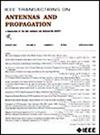FCC-FDTD(2,4)方法的复配发散ADE-CFS-PML及其数值性质
IF 4.6
1区 计算机科学
Q1 ENGINEERING, ELECTRICAL & ELECTRONIC
引用次数: 0
摘要
提出了一种时间为二阶、空间为四阶的面心三次时域有限差分(FCC-FDTD)方法的复频移完美匹配层(CFS-PML),称为FCC-FDTD(2,4)。为了将FCC-FDTD(2,4)方法应用于求解复杂电磁问题,通过辅助微分方程(ADE)提出了CFS-PML,提高了吸收性能,大大简化了时间推进公式的推导。由于FCC网格在空间上采用四阶采样方法,对计算域吸收边界界面进行了细致的分析。此外,所提出的方法还具有复杂发散性。然后,通过数值扫描方法找到了三个吸收边界本构参数的最优取值范围,并用遗传算法进行了验证。以电磁波传播、细细节多目标的电磁散射和大型飞机的电场分布为例,验证了该方法的有效性。结果表明,所建立的ADE-CFS-PML吸收边界对FCC-FDTD(2,4)方法具有良好的准确性和稳定性。本文章由计算机程序翻译,如有差异,请以英文原文为准。
Complying-Divergence ADE-CFS-PML for the FCC-FDTD (2, 4) Method and Its Numerical Properties
A complex-frequency-shifted perfectly matched layer (CFS-PML) for the face-centered cubic finite-difference time-domain (FCC-FDTD) method with second-order in time and fourth-order in space, termed as FCC-FDTD (2, 4), is proposed in this article. To apply the FCC-FDTD (2, 4) method in solving complex electromagnetic problems, the CFS-PML is proposed through an auxiliary differential equation (ADE), which enhances the absorbing performance and substantially simplifies the derivation of the time-marching formulations. Due to the fourth-order sampling approaches of FCC grids in space, the computational domain-absorbing boundary interface is carefully analyzed. Moreover, the proposed method exhibits complying-divergence. Then, the optimal ranges of three absorbing boundary constitutive parameters are found through the numerical sweeping method and verified by the genetic algorithm. Three numerical examples, the electromagnetic wave propagation, electromagnetic scattering of multiple targets with fine details, and the electric field distribution of a large-scale airplane, are carried out to demonstrate the performance of the proposed method. The results indicate that the developed ADE-CFS-PML absorbing boundary for the FCC-FDTD (2, 4) method shows good accuracy and stability.
求助全文
通过发布文献求助,成功后即可免费获取论文全文。
去求助
来源期刊
CiteScore
10.40
自引率
28.10%
发文量
968
审稿时长
4.7 months
期刊介绍:
IEEE Transactions on Antennas and Propagation includes theoretical and experimental advances in antennas, including design and development, and in the propagation of electromagnetic waves, including scattering, diffraction, and interaction with continuous media; and applications pertaining to antennas and propagation, such as remote sensing, applied optics, and millimeter and submillimeter wave techniques

 求助内容:
求助内容: 应助结果提醒方式:
应助结果提醒方式:


